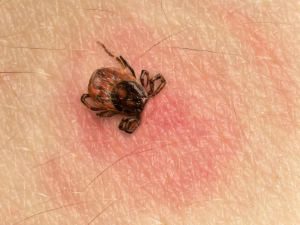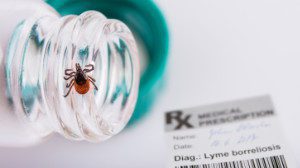THE LATEST ON TICK DISEASES IN THE NORTHEAST
By Chris Williams on November 27, 2019.
Health workers and researchers in the Northeast are becoming increasingly concerned about the increase in tick-transmitted diseases. It’s not just the increase in the incidence of any one disease but also the increase in the variety of tick-transmitted diseases out there. Used to be Lyme disease was the only real concern. Now other diseases, some very serious, are being found in high numbers as well, and the tick season just keeps getting longer — lasting well into late fall.

Tick embedded in human skin. Shutterstock.
IN NEW HAMPSHIRE, THE FIRST OCCURENCE OF A NEW DISEASE PATHOGEN
A study by BeBop Labs, a citizen science group, confirmed the thinking that tick bites and disease transmission occur all year-round, not just in spring and summer months. The group found that the threat of tick-borne diseases decreases during winter, but does not disappear entirely unless the ground is covered with snow.
“When we looked at what time of year do we find tick-borne diseases in ticks, there was no trend,” explained Kaitlyn Morse of the Plymouth labs. “It really looks like there are diseases all year round, even the coinfections; no spikes, no trends.”
The group analyzed 1,654 ticks sent in by volunteers in the past year. They found that between ¼ and ½ of the ticks tested carried at least one disease, usually Lyme. Between 5 and 10% of the ticks carried the disease pathogen, anaplasmosis. The study also produced the first New Hampshire documented presence of another pathogen in ticks called miyamotoi that causes flu-like symptoms.
IN MAINE, THEY’RE STILL WORRIED ABOUT LATE SEASON CASES

Black Legged Tick on medicine bottle. Shutterstock.
Officials in Maine are anticipating an all-time high this year for tick-transmitted diseases. The number of tick-borne diseases in 2019 was already higher than normal and more activity was expected in October and November, traditionally the second peak activity period for ticks.
The Maine Centers for Disease Control and Prevention reports a record high number of cases of babesiosis (124) and the current number of cases of anaplasmosis (556) is expected to surpass the record for that disease before the year is out. In contrast, the total number of Lyme disease cases should hit 1,000 by year’s end which is lower than either of the last two years.
“This has been one of the most active tick seasons we’ve ever seen in Maine – and it’s not over,” Maine CDC Director Nirav D. Shah said in a press release. “The risk of tick-borne illnesses remains high through November, so we urge everyone to protect themselves from tick bites.”
IN NEW YORK, POWASSAN DISEASE MAY BE MORE IMPORTANT
In upstate New York, a three month tick survey conducted by Professor Saravanan Thangamani of Upstate Medical University found that about 1/3 of the ticks submitted were found to be carrying at least one disease. As part of the Citizen Science Tick Testing Program, people across New York state were asked to send in any ticks they found on themselves, their kids, or their pets. From July 4 to October 18, the Lab received up to 70 samples per day for a total of 1,921 ticks.
Twenty-six percent of the ticks collected statewide tested positive for Lyme disease. In individual counties, percentages were often higher than 26%, with a few counties having close to 50% of their tested ticks carrying Lyme. The next step is to determine if these numbers also represent an increase in Lyme disease occurrences. “We are trying to work with clinicians to see if we can correlate what we see in the ticks to what they see in the patients,” said Thangamani.
But what concerns Thangamani more is the Powassan virus they found in ticks downstate. “It goes to your brain and 15 percent of the time, it’s fatal.” Fifty percent of the survivors of Powassan can also suffer lasting neurological effects.
The take-away from these tick disease studies is that it’s always tick season. The risk of tick bites and subsequent disease transmission are our new normal. Wear repellent whenever you are in tick areas.